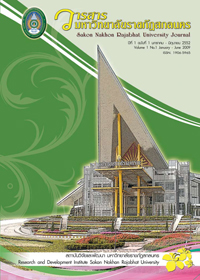การวิจัยเชิงปฏิบัติการแบบมีส่วนร่วมในการพัฒนาหลักสูตรวิทยาศาสตร์ท้องถิ่นสกลนคร
Abstract
บทคัดย่อ
การวิจัยนี้มีวัตถุประสงค์เพื่อพัฒนาหลักสูตรวิทยาศาสตร์ให้สอดคล้องกับสภาพปัญหา ความพร้อมและความต้องการของโรงเรียนและท้องถิ่นในจังหวัดสกลนคร การดำเนินงานได้ประยุกต์ใช้ระเบียบวิธีวิจัยปฏิบัติการแบบมีส่วนร่วม(Participatory Action Research :PAR) ตามกระบวนการพัฒนาหลักสูตรมี 6 ขั้นตอน ดังนี้ 1)วิเคราะห์ความพร้อมและความต้องการของโรงเรียนและท้องถิ่น 2) วิเคราะห์ความรู้ทางวิทยาศาสตร์ในภูมิปัญญาท้องถิ่น 3) พัฒนาหลักสูตรวิทยาศาสตร์ 4) ทดลองใช้หลักสูตร 5) ประเมินและปรับปรุงหลักสูตร และ6) สัมมนาและเผยแพร่ผลการใช้หลักสูตร ผู้วิจัยศึกษากรณีตัวอย่าง 1 โรงเรียน คือ โรงเรียนบ้านหนองมะเกลือ ตำบลดงชน อำเภอเมือง จังหวัดสกลนคร กับนักเรียนชั้นมัธยมศึกษาปีที่ 2 จำนวน 25 คน เป็นเวลา 16 สัปดาห์ ภาคเรียนที่ 2 ปีการศึกษา 2550 รวบรวมข้อมูลจากแบบสัมภาษณ์ แบบสอบถาม และแบบทดสอบวัดผลการเรียนรู้ วิเคราะห์ข้อมูลที่ได้จากแบบสัมภาษณ์และแบบสอบถามปลายเปิดด้วยการวิเคราะห์เนื้อหา และข้อมูลที่ได้จากแบบทดสอบและแบบสอบถามปลายปิดวิเคราะห์ด้วยสถิติ มัชฌิมเลขคณิต ร้อยละ ส่วนเบี่ยงเบนมาตรฐาน และการทดสอบค่าที
จากการศึกษาพบว่า
1. โรงเรียนและชุมชนบ้านหนองมะเกลือต้องการให้จัดสาระวิทยาศาสตร์บูรณาการกับภูมิปัญญางานจักสานจากไม้ไผ่ หลักสูตรที่พัฒนาขึ้นจึงจัดเป็นหลักสูตรบูรณาการระหว่างกลุ่มสาระวิทยาศาสตร์(เพิ่มเติม)กับกลุ่มสาระการงานอาชีพและเทคโนโลยี โดยให้ชื่อว่า “หลักสูตรวิทยาศาสตร์เรื่องงานจักสานจากไม้ไผ่”
2. หลังทดลองใช้หลักสูตรในเบื้องต้น พบว่า หลักสูตรมีประสิทธิภาพเป็นไปตามเกณฑ์ 75/75 และหลังทดลองใช้กับนักเรียนกลุ่มตัวอย่างพบว่า นักเรียนมีความรู้ในเรื่องที่เรียน และมีทักษะกระบวนการทางวิทยาศาสตร์หลังเรียนสูงกว่าก่อนเรียนอย่างมีนัยสำคัญ ที่ระดับ.05 และมีทักษะปฏิบัติงานสูงกว่าเกณฑ์ที่กำหนด (ร้อยละ 75) นักเรียนเห็นคุณค่าของภูมิปัญญาท้องถิ่น และมีความคิดเห็นต่อความเหมาะสมของหลักสูตรอยู่ในระดับมาก (4.19)
3. ผู้บริหาร ครู นักเรียน ผู้ปกครองและภูมิปัญญาท้องถิ่น มีความคิดเห็นสอดคล้องกันว่า หลักสูตรมีประสิทธิภาพเป็นไปตามหลักการและจุดมุ่งหมายที่กำหนดไว้ รวมทั้งช่วยให้โรงเรียนและชุมชนมีความสัมพันธ์ที่ดีต่อกัน และสามารถเป็นอาชีพเสริมได้
Abstract
The purpose of the research was to develop and study results from implementing local science curriculum in school at Sakon Nakhon province. The research and development which was a participatory action research was applied to this study. This research was composed of 6 following steps: 1) Analysing the local education needs for data base curriculum development. 2) Analysing Science content and wisdom. 3) Developing local science curriculum. 4) Implementing local science curriculum. and 5) Evaluating and Improving curriculum. 6) Seminar and dissemination. The researcher had studied one case : Bannongmaklor School with 25 students from Mathayomsuksa II for 16 weeks durin the second semester of 2007 academic year. The research instruments included lesson plans, dept interview, questionnaires, achievements test, The researcher analyzed data from case-study by content analysis, percentage, arithmetic mean, standard deviation and t-test
The research findings were summarized as follows : 1) The school and local education need developed curriculum was an integration of science and vocational and technological substances called science and bamboo weaving curriculum and Efficiency of local science curriculum was 75/75 2) After, The curriculum implementation was learning achievement showed that students’ post-test score were significantly higher than their pre-test score at .01 level and the average skills score could be passed criterion of 75 percent. Students had attitude toward local wisdom and average opinion on this curriculum was as a high level (4.19) 3) Administrator, teachers, students, parents, and wisdom specialist perceived that the curriculum was efficient according to the objectives and it also promoted good relationship between the school and community ,and could supplementary their income.









